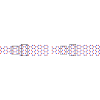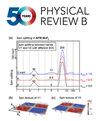带结点的石墨烯纳米带的有效理论
IF 3.7
2区 物理与天体物理
Q1 Physics and Astronomy
引用次数: 0
摘要
石墨烯纳米带是容错量子电子学的理想候选材料。在这种情况下,量子比特由局部态实现,局部态可以出现在由两条不同宽度的扶手纳米带形成的混合带的交界处。我们基于描述混合纳米带的紧束缚等式推导出一种有效理论,并用它准确预测了各种混合纳米带几何形状中的能隙和局域化性质。我们利用量子蒙特卡罗模拟证明了有效理论在存在哈伯德相互作用的情况下依然适用。我们发现,除了众所周知的交界处的局域化(我们称之为 "富士")之外,还有一种新型的 "乞力马扎罗山 "局域化,这种局域化涂抹在混合纳米带的一段上。我们的研究表明,当且仅当 N(mod3)=1 时,宽度为 N 和 N+2 的臂向纳米带混合体中的富士局域化会发生在对称交界处周围,而边缘对齐的交界处从不支持强局域化。纯粹依靠拓扑 Z2 不变式无法解释这种行为,而拓扑 Z2 不变式一直被认为是迄今为止局部化的起源。本文章由计算机程序翻译,如有差异,请以英文原文为准。

Effective theory for graphene nanoribbons with junctions
Graphene nanoribbons are a promising candidate for fault-tolerant quantum electronics. In this scenario, qubits are realized by localized states that can emerge on junctions in hybrid ribbons formed by two armchair nanoribbons of different widths. We derive an effective theory based on a tight-binding ansatz for the description of hybrid nanoribbons and use it to make accurate predictions of the energy gap and nature of the localization in various hybrid nanoribbon geometries. We use quantum Monte Carlo simulations to demonstrate that the effective theory remains applicable in the presence of Hubbard interactions. We discover, in addition to the well-known localizations on junctions, which we call “Fuji”, a new type of “Kilimanjaro” localization smeared out over a segment of the hybrid ribbon. We show that Fuji localizations in hybrids of width and armchair nanoribbons occur around symmetric junctions if and only if , while edge-aligned junctions never support strong localization. This behavior cannot be explained relying purely on the topological invariant, which has been believed to be the origin of the localizations to date.
求助全文
通过发布文献求助,成功后即可免费获取论文全文。
去求助
来源期刊

Physical Review B
物理-物理:凝聚态物理
CiteScore
6.70
自引率
32.40%
发文量
0
审稿时长
3.0 months
期刊介绍:
Physical Review B (PRB) is the world’s largest dedicated physics journal, publishing approximately 100 new, high-quality papers each week. The most highly cited journal in condensed matter physics, PRB provides outstanding depth and breadth of coverage, combined with unrivaled context and background for ongoing research by scientists worldwide.
PRB covers the full range of condensed matter, materials physics, and related subfields, including:
-Structure and phase transitions
-Ferroelectrics and multiferroics
-Disordered systems and alloys
-Magnetism
-Superconductivity
-Electronic structure, photonics, and metamaterials
-Semiconductors and mesoscopic systems
-Surfaces, nanoscience, and two-dimensional materials
-Topological states of matter
 求助内容:
求助内容: 应助结果提醒方式:
应助结果提醒方式:


